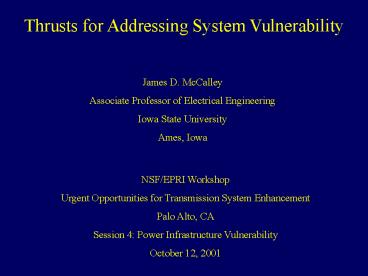Thrusts for Addressing System Vulnerability PowerPoint PPT Presentation
1 / 25
Title: Thrusts for Addressing System Vulnerability
1
Thrusts for Addressing System Vulnerability
James D. McCalley Associate Professor of
Electrical Engineering Iowa State
University Ames, Iowa
NSF/EPRI Workshop Urgent Opportunities for
Transmission System Enhancement Palo Alto,
CA Session 4 Power Infrastructure
Vulnerability October 12, 2001
2
Recommended Thrusts for Addressing System
Vulnerability
3
1. Rapid Response to Unfolding Events (RRUE)
- Motivating concepts
- Defense systems, last line of defense, safety
nets - The capability to arrest cascading/catastrophic
- disturbances after they are initiated and as
they unfold. - A generalization of the SPS (RAS)
4
1. Rapid Response to Unfolding Events (RRUE)
Can we automate the logic design of an
event-based SPS?
Very ambitious approach Develop logic after
disturbance sequence begins.
- Ambitious approach
- Develop logic in a preparatory mode.
- Prepare, store, and revise.
- Develop for near-term future high-risk periods
- Use continuous computing
- Need vulnerability analysis and storage tool
capable of - identifying most likely high-order events and
perform cascading analysis - performing short/mid/long-term time-domain
simulation - backing up
- organized method of storing logic for analyzed
events - the dynamic decision event tree (DDET)
5
Event Selector
Initiating Event List from first fault
6
1. Developing a DDET
Bus voltage
10 sec
1 min
7
1. Continuous computing and use of DDETs
24 hr load forecast at 8 am
Compute for next time period
Update pre-computed trees during high risk periods
Use pre-computed trees as event unfolds.
Pre-compute for high risk periods
8
2. Control room security-economy decision-making
(CR/SE/DM)
Operators view at 210 pm, 8/12/99
Imports
Bus 2 500
Bus 1 500
200 MW flow
94
110
Bus 1 230
Bus2 230
0.95 pu volts
Bus 1 115
Bus 2 115
93
9
2. Control room security-economy decision-making
(CR/SE/DM)
Simulation Results of a Preventive Action
Imports
Bus 2 500
Bus 1 500
0 MW flow
101
103
Bus 1 230
Bus2 230
0.91 pu volts
Bus 1 115
Bus 2 115
104
10
2. Efficient on-line comprehensibility of
security level
11
2. Control room security-economy decision-making
(CR/SE/DM)
12
3. Integrated Maintenance Selector and Scheduler
(IMSS)
Basic concept Merge RCM approach enhanced by
condition monitoring with system security
assessment
13
4. Energy Systems networks markets
14
Coupling within subsystems having finite supply
transport
15
Coupling between subsystems having finite supply
transport
16
(No Transcript)
17
(No Transcript)
18
Decisions and Decision Makers
Information and Information Flows
19
4. Distributed Information and Associated Flows
Basic facts
- Energy systems are saturated with decisions and
information, and both are highly distributed.
2. DMs make decisions based on the information
they have.
- 3. We are able to use information to make good
decisions when we - Can identify the value that is relevant to our
decision. - Know where the relevant information is located.
- Gain access to it.
- Can move and process it (or process and move it)
- Can integrate and synthesize it.
20
4. Distributed Information and Associated Flows
The underlying thesis
?There exists energy systems information networks
through which information flows. We can identify
these networks and associated flows, model them,
study them, identify their characteristics,
requirements, and influence, and we can control
and optimize them.
- Methods of approaching this
- Use a network
- nodes are decision-makers and information
repositories - branches are communication and processing paths
- Business system dynamics (J. Sterman, Business
dynamics Systems thinking and modeling for a
complex world, 2000) - Multiagent systems
21
5. Decision Making under Competition and
Distributed Information
- Operation of energy system infrastructure
requires coordination - Markets require competition between multiple
decision-makers, - inhibiting coordination
- How to have competition necessary for the
markets and the - coordination necessary for the integrity of the
physical systems
- Two approaches
- Identify essential decision-making and give
authority for that - to a centralized, neutral organization.
- Provide mechanisms which facilitate
decision-making through - negotiation.
The second one should be further explored.
22
5. Decision Making under Competition and
Distributed Information
- A software agent is a system situated within and
part of an environment that senses that
environment and acts on it, in pursuit of its own
agenda and so as to effect what it senses in the
future
- Multiagent systems (MAS) are systems of multiple
software agents that can communicate and
negotiate. - Distributed agent platforms provide MAS with
- Directory services
- Communication through interagent messaging and
conversation protocols - Coordination mechanisms that enable negotiation
23
A negotiated decision What should be the circuit
rating?
My Proposals
His offers
24
What do they negotiate about?
Coordination activities requiring multiple
decision-makers having different objectives,
such as
- Energy scheduling
- Price/quantity decisions on spot markets
- Transportation arrangements
- Maintenance scheduling
- Operational decisions (control
room/security-economy/decision-making) - Very fast corrective (self healing) actions
25
Summary
- Rapid response to unfolding events (RRUE)
- Control room security economy decision-making
(CR/SE/DM) - Integrated maintenance selector and scheduler
(IMSS) - Energy systems and information flow
- Negotiated decision-making

